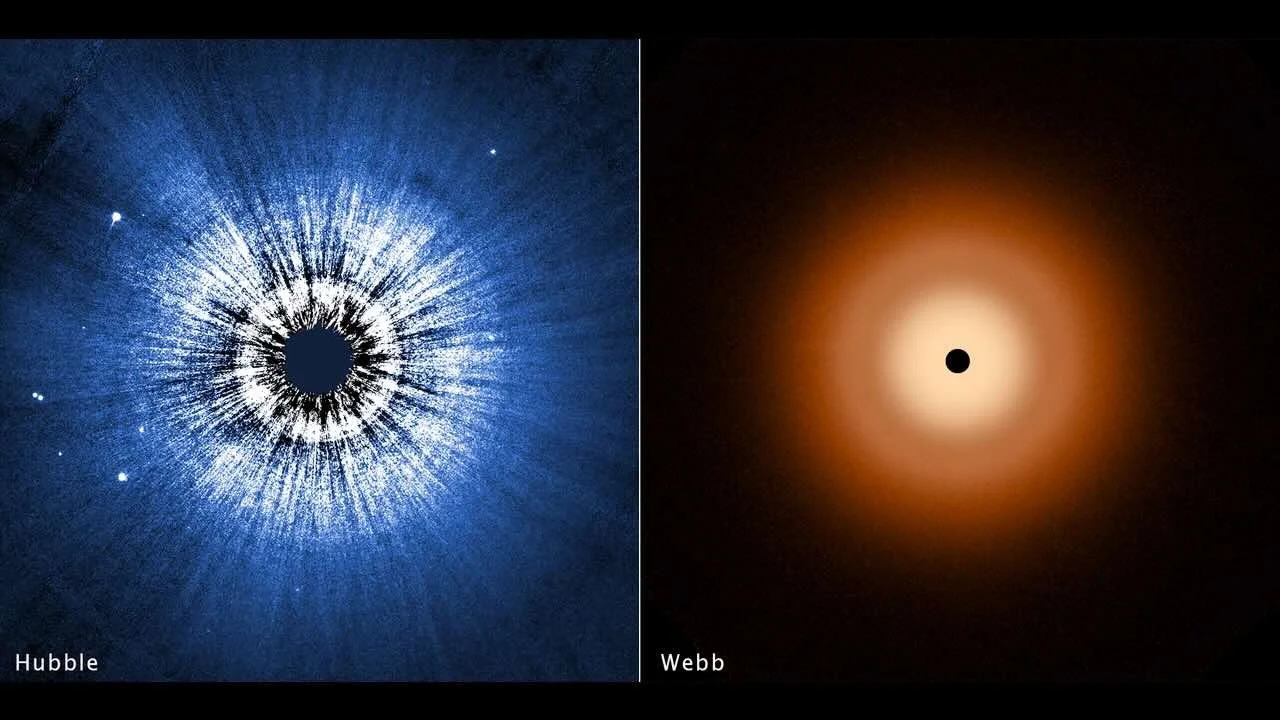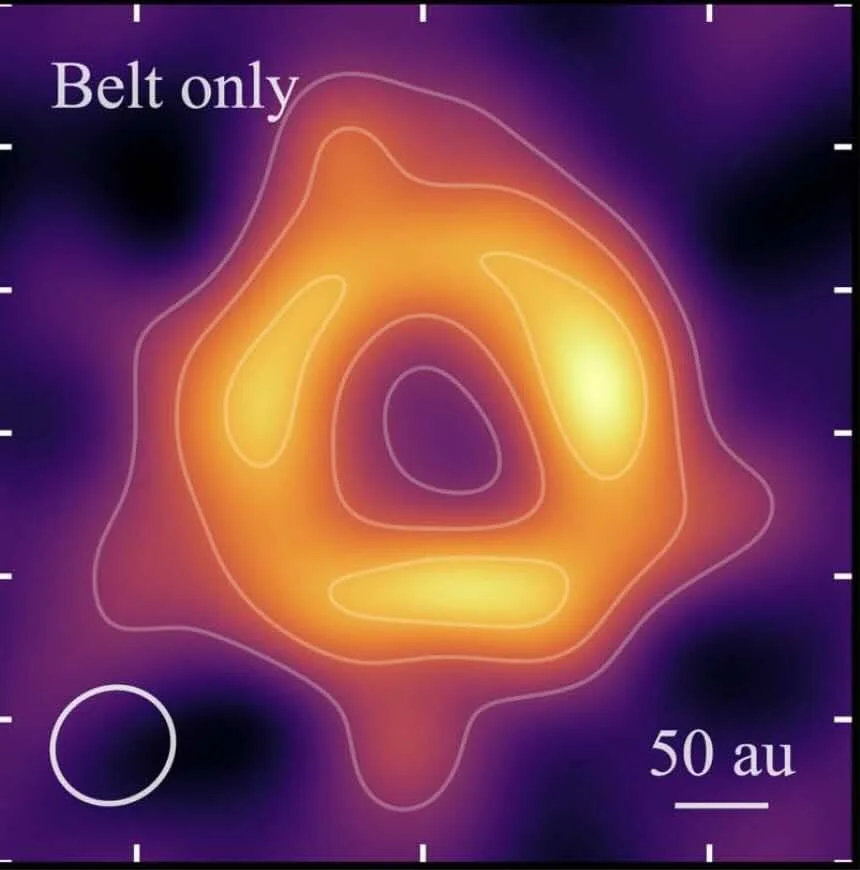The star Vega and its uncommon disk make the news again
Image Credit -NASA
Astronomers combined the power of the Hubble Space Telescope (HST) and the James Webb Space Telescope (JWST) to confirm that the well-defined disk surrounding Vega, one of the most well-known stars in the sky, has no giant planets [1].
Vega is the superstar
Vega is the second brighter star in the northern celestial hemisphere and the brighter star in the constellation of Lyra. Because of its proximity to the north celestial pole, it was even considered the pole star in ancient times. Even in a light-polluted city, this star cannot be missed.
In the 1950s, thanks to the astronomer Harold Lester Johnson, Vega became an important star for modern astronomy. Johnson made Vega the zero point and used it to determine the colors of other stars. For this, Johnson introduced three special filters, the Ultraviolet, Blue, and Visual (UBV) photometric system. Facilitating the brightness comparison against Vega and determining a color value for any star.
Vega as a ruler
But how can we achieve this? Think about a ruler where Vega is the zero point for all colors. If we observe a star with one of the filters in the UBV and it is dimmer than Vega, its magnitude is a positive value. Now, use these same filters to observe Vega with any telescope on Earth or space. In that case, you can establish the zero point for that observatory and compare your data with that of other astronomers worldwide.
However, using a star like Vega, an A0V type star, was not arbitrary. Astronomers believed that a star of this kind did not have a disk or a source of reddening, making it an excellent candidate to calibrate observations. However, the more they observed it, the more they suspected it had a disk.
Vega, the test ground for debris disks
The Infrared Astronomical Satellite (IRAS), the first infrared telescope in space, found that Vega had a disk in 1984[2]. Later, in 2005, NASA’s infrared Spitzer Space Telescope mapped out the disk, finding a ring of dust around Vega [3]. In these observations, astronomers concluded that the disk indicated the possible presence of planets within warm inner and colder outer belts. Another proposed explanation is a ring associated with a population of larger asteroidal bodies like those in the Solar System’s Kuiper Belt[4].
In 2006, astronomers got more images of the disk using Caltech’s Submillimeter Observatory on Mauna Kea, Hawaii. These showed a ring-like morphology at a radius of ∼ 100 AU, probably with grains of about 1 mm in size. Combined with the observations from Spitzer, the grains seemed to be concentrated in three different locations. Something they attributed to be produced by planetary resonances[5].
Another piece of the puzzle came with the observations made in the infrared with ESA’s (European Space Agency’s) Herschel Space Telescope in 2010. These observations reveal that the structure of the disc was smooth, with no clumpy structure, at least to the sensitivity limit of the data[6].
More recently, astronomers observed the colder dust in Vega using the Atacama Large Millimeter/submillimeter Array (ALMA) in Chile. These observations provided three different scenarios that could explain the observations:
A planetless scenario with an outer belt that was born with the observed sharp inner edge.
A chain of closely spaced planets, with an outermost planet of mass ≥ 6 earth masses at ≲ 70 AU from the star. These planets must truncate the inner edge of the outer belt, producing the hot and warm dust observed in the inner regions of the system and
A lone outer giant planet, with mass up to the limit provided by direct imaging, this is ∼5 at 50–60 au)[7].
The observations of HST and JWST
Using the combined power of HST and JWST, astronomers took a more detailed view of the warm dust disk surrounding Vega. While JWST reveals the infrared glow from a disk of particles the size of sand, Hubble captures an outer halo of this disk, with particles no bigger than the consistency of smoke that are reflecting starlight.
The observations revealed a large disk with a radius of 513 AU. This disk, between ∼80 to ∼170 AU, coincides with the planetesimal belt detected with ALMA. The inner part is filled with warm debris that shines most efficiently in the mid-infrared. The JWST observations also reveal a shallow flux dip or gap at 60 AU from the star. With these observations, astronomers conclude that no Saturn-mass planets are orbiting the star outside about 10 AU.
Furthermore, the Vega disk is incredibly smooth. The material is arranged by the difference in pressure that Vega’s radiation exerts on particles of different sizes. If a giant planet were present, we would see a clear gap resulting from the planet’s plowing of dust as it orbits the central star.
Lessons learned
One could argue that stars like Vega have a smooth disk and don’t give rise to planets. However, this is not what similar stars tell us. Fomalhaut, a close star of similar age and temperature as Vega, shows three nested debris belts, indicating planets forming there. Also, in Fomalhaut, the light is confined to the narrow outer debris belt, while Vega has a far more extended distribution. The difference can only indicate a variety of disk fates for the same type of stars. Some of them will not form giant planets like Jupiter and Saturn.
But let’s move to conclusions slowly. Although Fomalhaut is about the same distance, age, and temperature as Vega, it is colder. This makes it difficult to conclude if the formation of stars depends on the environment where the star formed or if the star itself is responsible for the difference.
In the future, we will see more studies focused on these types of stars. Hopefully we learn more about what defines the formation of planets and their distribution of sizes.
References:
[1] https://science.nasa.gov/missions/hubble/nasas-hubble-webb-probe-surprisingly-smooth-disk-around-vega/
[2] Auman, H.H. et al. 1984, ApJ, 278, L23
[3] https://www.spitzer.caltech.edu/news/ssc2013-02-nasa-esa-telescopes-find-evidence-for-asteroid-belt-around-vega
[4] Su, K. Y. L. et al. 2005, ApJ, 628, 487 https://arxiv.org/abs/astro-ph/0504086
[5] Marsh, K. A., et al 2006ApJ,646,L77-https://arxiv.org/pdf/astro-ph/0606347
[6] Sibthorpe, B. et al 2010, A&A 518, L130
[7] Matrà, L. et al 2020, The Astrophysical Journal, 898:146

